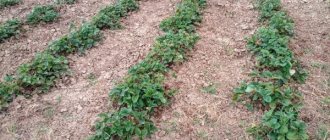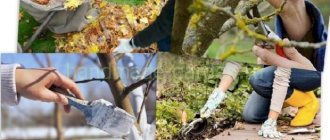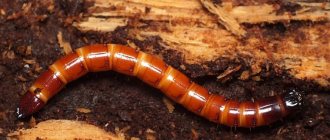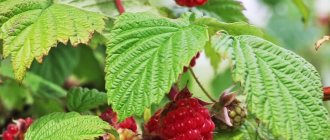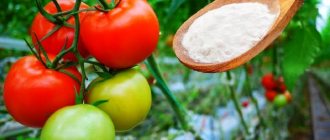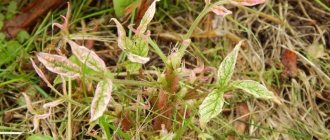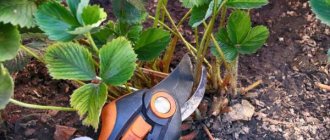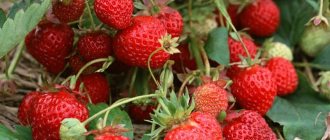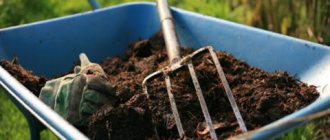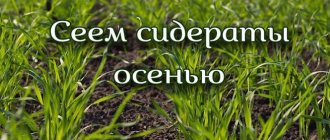Although garden strawberries are considered a low-maintenance crop, they require high-quality and timely feeding. This is how its root system works. In our article you will learn how to fertilize strawberries in the fall and when to do it correctly.
Why fertilize?
Garden crops differ significantly from their wild relatives. Strawberries are no exception. The fruits are significantly, sometimes tens of times, larger, usually there are many more of them, and the fruiting period is longer, and in remontant varieties this process can continue until the first snow.
The abundance and size of the fruits necessitate annual feeding, and if this is not done, the yield in 2-3 years will actually approach that typical for wild strawberries growing in natural conditions (3-5 berries).
Without feeding, any of the modern varieties behaves the same. The berries become smaller and their number decreases. The fibrous root system quickly draws out the substances it needs from the top layer of soil, and since there is no main root that could grow into deeper layers, replenishment from them is impossible. Experiments with planting other plants will not yield anything; in a year or two everything will happen again.
Only timely fertilizing with mineral and organic fertilizers can save the situation. Autumn feeding is especially important, since plants need to prepare for winter in order to survive it without losses and begin the next equally abundant fruiting.
Preparing for winter cold
The last step in preparing strawberries for winter is mulching and insulation. In general, strawberries tolerate winter well, but in some cases they require additional help.
If frost has already struck, but there is no snow, then the bushes must be covered with spruce branches or straw. Using additional mulch will help you survive sudden temperature changes.
With the onset of stable frosts, strawberries must be covered. To do this, use a special covering material, humus or leaf litter, which is pressed on top with spruce branches.
When is the best time to feed strawberries in the fall, optimal timing
The optimal time for fertilizing in the fall is September.
In warmer regions you can also feed in October. It is undesirable to carry out the procedure later, as this affects the plant’s resistance to frost.
Experienced gardeners advise feeding strawberries with nutrient mixtures at the same time as trimming old leaves.
Before applying liquid fertilizer, be sure to water the soil under the strawberries to avoid chemical burns to the roots.
The best fertilizers for strawberries
What distinguishes the crop from other fruit and berry plants is its root system. According to the biological structure, the root system of garden strawberries is fibrous, up to 30 cm long.
It is necessary to ensure the optimal content of all available nutrients in a small fertile layer:
- high doses of phosphorus fertilizers;
- regular potassium supplements;
- organic.
What is the best way to feed strawberries in the fall, what kind of fertilizers - we will consider further.
Organic
Organic fertilizers are especially necessary for light and medium soils. Strawberries are very demanding on root respiration; they develop and bear fruit poorly in heavy clayey, floating soils.
In soils with a heavy composition, for looseness and breathability, the following must be added:
- sand;
- compost;
- sawdust;
- broken red bricks (crumbs).
From September to the first ten days of October, bird droppings diluted in water in a ratio of 1:15 (no less) are added to the soil. Moreover, you need to add liquid fertilizer only to well-watered ridges.
Mullein is a less concentrated fertilizer; liquid solutions are diluted in a ratio of 1:10. The feeding method is similar - the beds are thoroughly watered in advance, then the working solution is poured under the root of the bush.
Mineral fertilizers
In the autumn months, strawberries most need substances containing nitrogen and potassium.
- Potassium mixtures extend the shelf life of berries, give them sweetness and improve their taste. The fact that plants do not have enough potassium is indicated by the browned tips of the leaves and the sour taste of the berries. Potassium salt is added to water at the rate of 2 g per 1 liter and watered between the rows.
You can also take 15 g of potassium salt and 20 g of nitrophoska, mix with 10 liters of water and water 10 bushes.
The source of nitrogen fertilizers is urea or ammonium nitrate. Thanks to nitrogen, the berries grow faster, become rich red and their taste improves. With excess nitrogen, berries lose sugar. A lack of nitrogen can be recognized by pale leaves and small berries. For root application 1 tbsp. l. urea is diluted in 10 liters of water. This is enough for 20 bushes.
You can additionally prepare a mixture of organic and mineral fertilizers. To do this, take 10 liters of water, 1 glass of ash, 1 liter of mullein and 2 tbsp. l. superphosphate. This mixture is used at a rate of 10 liters per 1 sq. m.
- Hydrogen peroxide is also suitable for use as a power source. It increases the oxygen content in the soil, which promotes the absorption of nutrients. To prepare a nutrient solution, take 2 tbsp. l. 3% hydrogen peroxide and 1 liter of water. The product consumption is 200 ml per bush.
- Superphosphate is recognized as one of the most effective fertility vitamins. It is diluted with water at the rate of 10 g per 10 liters and watered over the strawberries in the afternoon. Avoid getting the solution on the leaves.
- Copper sulfate destroys pests and their larvae. Enriches the soil with copper and sulfur and is a preventative against many diseases. It is best to spray plants with a 3% solution in the evening.
- Ammonia helps plants, exhausted after fruiting, prepare for winter. 150 ml of ammonia is mixed with 10 liters of water and 2-3 drops of iodine are added. Strawberries are watered from a watering can.
Combined fertilizers
The first way to get mixed fertilizer is to take 250 g of ash, 30 g of nitrophoska and 20 g of potassium chloride. All components are added to 10 liters of water and the plants are watered at the rate of 1 liter per bush.
They also make a mixture of humus, superphosphate and potassium fertilizers. The amount of substances is affected by the type of soil. For normal soil, 2.5 kg of humus, 20 g of superphosphate and 10 g of potassium per 1 square meter will be enough. m.
Folk recipes for homemade fertilizers for strawberries
Make organic infusions for feeding strawberries yourself at home simply from available ingredients:
- herbal fermenters;
- fertilizing with black bread;
- yeast infusions;
- slurry;
- compost teas.
Preparation of slurry takes 2-3 days:
- mullein is filled with water in a ratio of 1:8-10;
- the slurry is infused for up to 3 days (until bubbles appear on the surface):
- The consumption rate is 0.5-1 l for each berry bush.
In the summer, wide row spacing of strawberries is mulched with fresh sawdust and rotted manure. Such shelter is beneficial from all sides:
- protects the soil from overheating in the summer heat (the root system does not suffer);
- maintains soil moisture;
- especially sawdust does not allow weeds to break through;
- The rooting of the mustache is superficial; it is easy to separate new shoots that have grown into the sawdust from the bush.
Features of preparing nettle or herbal infusion:
- a barrel or large plastic bucket is filled 2/3 tightly with chopped herbs;
- fill it to the top with water, cover the container with a bag;
- the infusion ferments under the sun, in a warm place, the container is placed in a warm, well-lit place;
- nettle fermentation must be kept in the sun for at least 7-10 days;
- The prepared infusion is added to the irrigation liquid and the bushes are spilled with the working solution.
Ash as a valuable fertilizer for strawberries (containing phosphorus, potassium, calcium) is applied in dry and liquid form. Ash solutions are prepared before application to the soil:
- Pour 100-200 g of ash with hot water, 1 liter:
- dissolve, add 8-9 liters of warm water;
- consumption for each bush is 0.5 l (wet ridges are shed).
Measures of ash: in 1 faceted glass - up to 100 g of ash, in a full matchbox - 10-12 g, in 1 tbsp. spoon - 5-6 g.
Reference. If you add grated laundry soap (a third of a piece) to the ash solution and spray the bushes, you can protect the strawberries from flies, caterpillars, moths and other dangerous pests.
Signs of lack or excess of minerals in strawberries
You can find out that this plant lacks some macro or microelements by its foliage - it changes its color. Signs of such a deficiency are as follows:
- when there is a lack of nitrogen, the foliage becomes paler in color, may turn yellow, its growth slows down, and as a result, it falls off prematurely. The leaf blades quickly turn yellow, but the veins remain green. But the color of the foliage can turn purple with a reddish tint;
- A lack of phosphorus primarily affects ripening berries - they lose their taste and become too soft. And the leaves acquire a dark brown color, which worsens in cold, dry times;
- with potassium deficiency, the lower leaves of the plant are the first to suffer - the edges of the leaves begin to turn red, and over time the color of the entire leaf plate changes;
- With calcium deficiency, young leaves do not unfold and their tips begin to darken.
Excess of mineral fertilizers is also harmful and is expressed in an overly saturated color of the leaf blades of strawberries, interveinal chlorosis may appear, and the growth of the above-ground and underground parts of the bushes slows down. Yellowing of the leaf edges may also occur.
What not to feed strawberries in the fall
Not all preparations are suitable for feeding.
For example, you should absolutely not use nitrogen fertilizers (urea, ammonium nitrate).
The fact is that nitrogen provokes the growth of leaves and tendrils on the plant, which is completely unnecessary before the onset of cold weather.
IMPORTANT! It is better to use fertilizers in the form of liquid solutions in the first ten days of September, when it is still quite warm outside. When fertilizing in October, it is better to incorporate granular mineral fertilizer into the soil.
Schemes for autumn feeding of strawberries
Now let’s look at the most common feeding schemes for this crop in the fall.
The standard scheme includes 2 fertilizer applications. The first time you need to feed it is in early September. The second is to feed in the last days of September (for colder regions) or the first days of October (for southern regions).
First scheme
In September we feed strawberries with “Kemiroy Lux” (50 g per 1 sq m of beds). In October we fertilize with potassium humate (according to the instructions).
Second scheme
September: solution of mullein (10 l) and wood ash (200 g).
October: complex composition of wood ash (200 g), water (10 l), nitrophoska (40 g), potassium salt (20 g). Each bush is watered separately with this liquid mixture.
How to feed strawberries in the fall after transplanting
If you are transplanting and propagating strawberries in the fall, then the crop must be fed.
The soil under the beds is fertilized with a complex composition consisting of humus (3 kg), superphosphate (40 g) and potassium chloride (10 g). This amount of fertilizer is enough for 1 sq. m.
If you did not add mineral fertilizers when you planted the young rosettes, you can water the bushes with ash infusion or bone meal extract.
If you prefer mineral fertilizers, you can feed them exclusively with a liquid solution of superphosphate.
Preparatory activities
Before you start fertilizing strawberries in the fall, you need to carry out several preparatory procedures.
Pruning strawberry bushes
- First, the bed is inspected, all the tendrils that the bushes have sprouted, if not needed, are removed.
- It is also necessary to trim bad leaves from bushes. This includes leaves damaged by pests, diseased ones, those that are simply withered or almost completely dry. Only the greenest and most beautiful ones are left.
- Now all weeds are removed. There is no benefit from them - they only draw juices from the ground, especially if they are perennial weeds.
How to feed strawberries in the fall after pruning
After this procedure, the culture is fed with the same phosphorus- and potassium-containing preparations. But there is one caveat.
Sanitary pruning of old leaves is usually carried out at the very end of the season, the last days of September - the first days of October. At this time, liquid medications cannot be used. Otherwise, there is a great risk of ruining the culture.
Therefore, it is necessary to use dry fertilizers. For example, manure that is scattered between the rows is suitable from organic matter. It is allowed to take almost any mineral fertilizer, but just do not prepare a solution from it, but incorporate it into the soil in dry form.
Common mistakes
- Using large amounts of nitrogen-containing fertilizers. This provokes the growth of green mass. Before winter, this is dangerous, since the shoots can be damaged by frost.
- Application of fertilizing at the wrong time. It is necessary to add nutrients in due time, otherwise they will not be absorbed by the plant and will not bring the desired result.
- Use of highly concentrated formulations. The working solution must be prepared according to the instructions, otherwise there is a high risk of burning the roots of the plant.
- Dry granules are not embedded in the soil, but remain on the surface. Because of this, the fertilizer does not work. For dry fertilizing to have an effect, the granules need to be embedded in the soil, where they will decompose and release nutrients.
Feeding remontant strawberries in the fall
For remontant varieties, soil preparation in the fall is very important. This variety bears fruit almost the entire season, so it is important that the soil is nutritious.
If you do not apply fertilizers during the season, then in the fall you need to add the following complex: 50 g of superphosphate, 20 g of potassium sulfate, 8 kg of humus (can be replaced with manure or compost). All this for 1 sq. m.
Also, for remontant varieties of strawberries, a solution of superphosphate and wood ash will be useful. The complex composition is prepared as follows.
Take 2 tablespoons of superphosphate, which are filled with hot water (about 1 liter) for a day. Next, the volume of liquid is adjusted to 10 liters and 0.5 kg of wood ash is added. Mix everything thoroughly until a homogeneous consistency is obtained and water the bushes at the root.
Don't forget to mulch the soil in the fall. This way you will protect the strawberry root system from freezing.
Useful video
Care of strawberries after harvest - video
Caring for strawberries in the fall, feeding and protection from diseases and pests - video
Nutrient supplements in autumn are very important for the full development of strawberry bushes. The abundance of flowering, the number of flowers, ovaries and future harvest, the taste and size of the berries depend on the correct choice of fertilizer. The main thing is that fertilizers are supplied in the required volume. Excess in this case will only do harm. With the right approach, the root system will receive a sufficient amount of nutrients and spend the winter with dignity, and the crops will certainly be rewarded with a generous harvest of healthy fruits.
